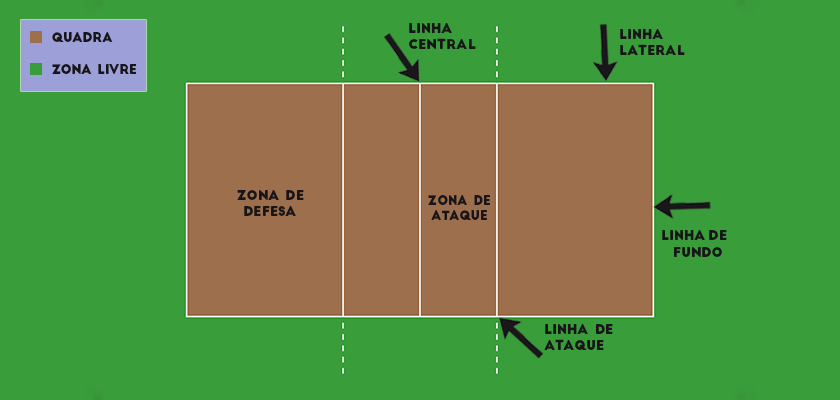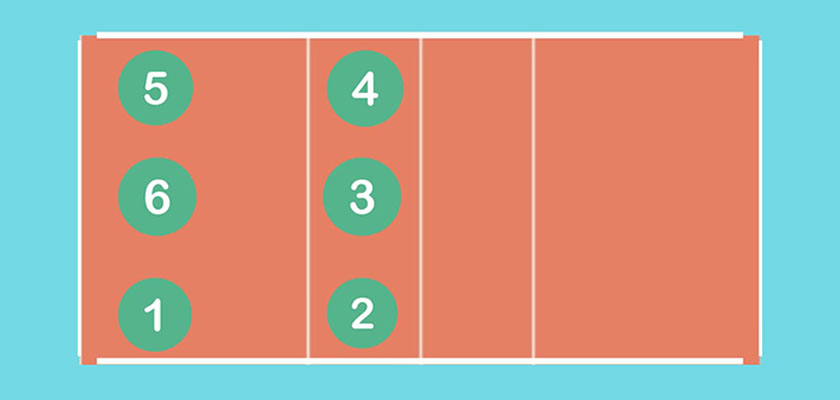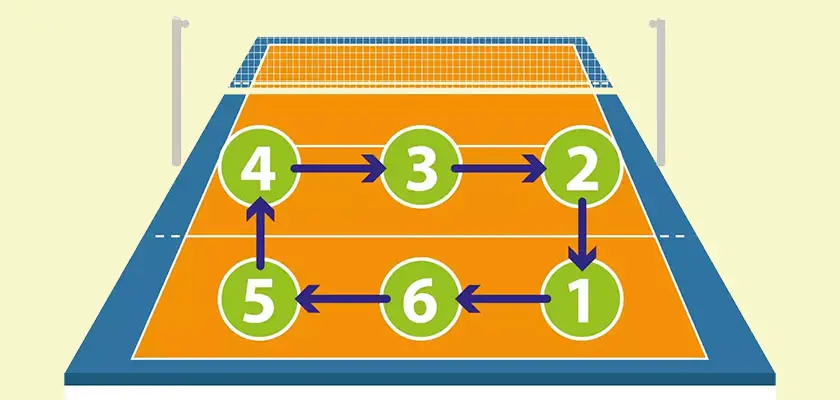Volleyball, a dynamic and passionate sport, has won hearts around the world, transcending cultural and geographical boundaries.
In this complete and up-to-date guide, we’ll introduce you to everything about the sport, from its historical origins in the United States to the intricacies of the positions on the court.
Get ready to dive into the emotions, strategies and fundamentals that make volleyball not just a game, but a unique competitive experience.
By reading to the end, you’ll know all the rules and be able to watch the various championships that take place from time to time.
Check it out 👇
What is the aim of volleyball?
Volleyball is a team sport characterised by fast movement, use of the arms and teamwork. Played on a court divided by a net, the aim is to make the ball touch the ground in the opponent’s court.
Two teams made up of six players compete in a strategic battle to gain points and win the match. Each team has the right to touch the ball up to three times before sending it back to the opposite side.
The game begins with a serve, where one player launches the ball into the air and hits it hard towards the opponent’s court. From that moment on, the action unfolds through numerous basic fundamentals, such as passing, lifting, cutting, blocking and defending.
This dynamic creates an intense choreography during the game, making it a captivating sport for athletes and spectators alike.
Volleyball origins
Volleyball originated in the United States at the end of the 19th century. Its creation is credited to William Morgan, a physical education teacher at the YMCA in Holyoke, Massachusetts.
Morgan’s aim was to create a sport that could be played indoors, such as gyms and arenas, during the winter period.
Initially called “mintonette”, the sport had a higher net than today’s and slightly different rules to modern volleyball.
In 1896, the sport was renamed volleyball due to the nature of the game, where the ball was “volleyed” back and forth over the net. After that, it gained a competitive nature, stricter rules and, above all, professionalism.
The sport quickly spread around the world, especially after the First World War, when US troops introduced the game to different countries.
The International Volleyball Federation (FIVB) was founded in 1947, providing a global organisational structure for the sport.
Since then, the sport has evolved significantly in terms of rules, techniques and tactics, becoming one of the most practised and watched sports on the planet.
Volleyball matches
Volleyball matches are played in a best-of-five sets system. To win a set, a team must score 25 points before their opponents, with a minimum difference of two points.
In other words: if the set reaches a score of 24-24, the teams play endlessly until someone manages to score two points.
The fifth and final set is shorter. It’s called a tie-break and lasts just 15 points instead of the traditional 25. The two-point difference rule also applies for the set to be declared a win.
Each team has the right to request two time-outs in each set. This lasts 30 seconds and must be requested by the coach or, in his absence, by the team captain – always with the ball out of play.
How many players are there in volleyball?
A volleyball team is made up of six starting players. The bench, on the other hand, can be made up of up to six substitutes.
Each starter can only be replaced once per set. If they need to return to the court, they take the place of the substitute.
Once they return to the court in the same set, they cannot be replaced a second time, only in the event of injury.
Volleyball court

The volleyball court is a rectangle 18 meters long by 9 meters wide. In the middle of it, there is a center line that divides the area into two parts. Each team is positioned in one half.
In addition to the center line, there are two side lines and two end lines, which delimit the boundaries of the court. These are what determine volleyball points.
There are also two lines positioned three meters from the center line. These are called attack lines (or lines of three) and they define the attack zone.
According to volleyball rules, attacks can only be made within the attack zone. That’s why they are so named.
The other part, behind the attack lines, is called the defense zone. This is where the players usually receive the opponent’s shots.
Outside the demarcation of the court, there is a special perimeter called the free zone, which must exist without any kind of obstacle.
The free zone is painted a different color and is 5 meters from the sidelines and 6.5 meters from the end lines of the court.
Balls that land in the free zone without any opposition interference are considered “out”. Despite this, players can use it at will to move around, make touches and carry out attacks.
The net sits right on top of this center line. It is 2.43 meters high in men’s games and 2.24 meters high in women’s games.
Finally, there are two antennas positioned on top of the net. They are 1.8 meters high and are very important for the game.
Volleyball fundamentals
- Serve
- Reception
- Lifting
- Attacking
- Blocking
Serve

The serve is the movement that starts the point and is performed behind the back line of the court. The player must play the ball to the opponent’s side without stepping on the line or invading their own court.
During the journey, the ball must pass through the net. If it hits the net and doesn’t land on the opposite side, it’s a point for the opponents.
The attacking team continues to serve with the same player until the opposing team scores a point. If this happens, the serve changes sides.
The serve can be performed in two ways. The most common way used in professional matches is to throw the ball up, jump and hit it with an open hand.
The other procedure is more commonly used by people who are just starting to learn the sport and consists of hitting the ball with a closed hand.
Reception

Reception is the act of receiving an opponent’s ball on your own court, whether it’s a serve, an attack or the return of a block.
This defensive execution is usually done with the headlock – a procedure in which the player brings his hands together while keeping his arms straight.
The reception, however, can be made in other ways: with both hands raised upwards, using only one hand (closed or open) or, in exceptional cases, even with the feet (yes, this is allowed according to volleyball rules).
It’s worth noting that if the ball hits the net, the play can still be continued, as long as the team doesn’t exceed the three-touch limit.
Setting

When a team successfully receives an opponent’s ball (first touch), the second touch is usually a setting.
The tackle is the preparation for the attack. This movement is done, in the vast majority of cases, with both hands pushing the ball upwards.
In this way, the ball is at a good height for a teammate to cut it and consequently score a point on the opponent’s court.
This is the ideal way, but the lift can also be done from the baseline or using just one open hand.
Attacking

The attack is usually the third and final touch of the move, designed to put the ball on the opponent’s floor and score.
The most common form of attack is the cut, i.e. when an athlete uses the palm of their hand to throw the ball into the ground with force and speed.
There is also the deixadinha. This movement is more subtle than the cut. The ball picks up less speed and falls gently to the ground. This move is perfect for tricking well-placed blockers at the net.
Finally, there’s the “second attack”, occasionally performed by setters. Instead of lifting the ball (third touch), the setter can pass it directly to the other side in order to score.
The three players in the front positions can only attack within the attack zone. The three players at the back (with the exception of the libero, who can never attack) can only cut behind the line of three.
Blocking

When one team attacks, the other team can parry the ball by jumping with their arms out. This movement is called a block.
Blocking can be done by one, two or even three people jumping at once. It’s a device for cushioning cuts as well as scoring points.
Volleyball rules
The most traditional way to score in volleyball is to play the ball within the boundaries of the opponent’s court, either directly or with someone’s touch along the way. This can be done by attacking, serving or blocking.
If during an attack, serve or block the ball goes outside the court (free zone) without any interference from the opponent, the team does not score a point. In this scenario, the point in question goes to the opposing team.
However, if a ball goes out of bounds, but the last touch is made by the opposing player, the point goes to the attacking team.
There are other ways of scoring in volleyball:
- If an opposing player touches the net, hindering play;
- If an opposing player invades the opponent’s court, either above or below the net;
- If an opposing defender attacks by stepping on the attack line or invading the offensive zone;
- If an opposing player takes a longer touch on the ball, which is known as a charge or drive;
- If an opposing player touches or attacks a ball at the net antenna;
- If an opposing player serves the ball and it does not pass the net;
- If an opposing team takes more than three touches of the ball.
Court volleyball positions

One of the most important points of the volleyball rules is that players must respect a system of positions on the court.
These positions are numbered from 1 to 6, i.e. exactly the number of starting players on a team in a volleyball match.
The number 1 position is that of the server, i.e. the player on the right side of the defense. The number 2 position is just in front of him, but inside the attack line, close to the net.
The number 3 position is in the middle of the net, while the number 4 position is on the left side of the attack.
Finally, positions 5 and 6 complete the back of the court. They are on the left and in the center of the defense respectively.
The official names are:
- Position 1 – Right defense (serve);
- Position 2 – Net outlet;
- Position 3 – Middle of the net;
- Position 4 – Net entry;
- Position 5 – Left defense;
- Position 6 – Central defense.
Volleyball rotations

The players don’t stay static in their positions on the court. There is a rotation system, also known as rotation. Within the rules of volleyball, this is perhaps the element that generates the most doubt. But don’t worry, we’ll explain!
Whenever a team serves, they rotate clockwise. Whoever was in position 1 goes to 6. Whoever was in position 6 goes to 5. And so on. We’ve put an image above to illustrate.
If the serving team scores, there is no rotation on the next point. The same player will serve until his team loses a point.
It’s worth noting that the players don’t have to follow the positions of the rotation faithfully. As soon as the server hits the ball, the players can move anywhere on the court. There are, however, some limitations.
Those who start in the defense zone can only attack by jumping from behind the three-point line. Liberoes, on the other hand, can only start in defensive positions. When they reach the net (position 4), they must be replaced.
The positions in volleyball are purely geographical, i.e. they define the player’s position in relation to the court. Roles, on the other hand, refer to the responsibilities of each player within a team. We’ll look at this next.
Player roles

- Setter
- Opposite hitter
- Outside hitter
- Middle blocker
- Libero
Setter
The setter is responsible for lifting the balls to the attackers, i.e. the second touch of the ball. They work in the middle of the court, always close to the net. The player in this position needs to be intelligent, creative and a good passer.
Opposite hitter
The opposite hitter is a specialist in attack only. They get this name because they are in the opposite position to the lifter. Example: if the setter is in position 2, the opposite will always be in position 5.
The opposite hitter likes to attack from the wings (when he’s in the attacking zone) and from deep, jumping before the three-man line (when he’s in the defending zone), always giving priority to positions 2, 4 and 1 (in order of importance).
Outside hitter
The outside hitter is a complete player. He needs to be good both offensively and defensively, i.e. in attacks and receptions.
Teams usually play with two oOutside hitters in the starting line-up, always in opposite positions. In other words, if one point guard is in position 1, the other needs to be in position 4. This provides security for both areas of the court.
Middle blocker
The middle blocker is the player who stands in the middle of the net. They are usually the tallest players on the team, but the slowest.
The middle blocker is a good attacker of fast balls through the middle and also an excellent blocker. They don’t need to attack from the sides, because the point player and the opposite player are there. Another characteristic of the central middle blocker is that he doesn’t play defense.
When the middle blocker comes in at position 1, he serves and, at the next point, is immediately replaced by the libero, only to return at position 4.
Libero
The libero was created in 1998, which means it didn’t exist in the early days of volleyball. The libero is an exclusively defensive player who can only play in the defense zone positions, i.e. 1, 6 and 5.
In other words: the libero can’t serve, attack, block or take part in the attacking positions, i.e. 2, 3 and 4. This position is only allowed to receive serves, defend attacks and play the ball.
When the libero arrives at the net, he can be replaced by any other player without having to notify the referee.
Another peculiarity of the libero is that he plays in a different colored shirt from the other players, precisely to make it easier for him to move around the court.
How important is volleyball?
- Well-being | Volleyball is a physical activity that promotes health and well-being. By practising the sport, players improve their cardiovascular condition, develop motor skills, promote coordination and strengthen their muscles;
- Social inclusion | Volleyball is accessible and can be practised by people of different ages and abilities. This promotes social inclusion, providing opportunities for diverse groups to participate, regardless of gender, age or socio-economic background;
- Social skills | Volleyball is a team sport that requires communication, co-operation and teamwork. Players learn to collaborate, deal with wins and losses, and develop valuable social skills that are applicable in various aspects of life;
- Competition | Volleyball provides a favourable environment for healthy competition, encouraging personal achievement, respect for opponents and sporting ethics. These values are fundamental to the development of athletes and responsible citizens;
- Professional development | Volleyball can offer professional development opportunities for athletes, coaches, referees and other sports-related roles. This includes careers in sport, physical education, sports coaching and management;
- Entertainment | Volleyball is a source of entertainment for millions of fans around the world. National and international competitions, such as the Olympics and world championships, attract large audiences.
Now you know everything about volleyball, such as its history, fundamentals and main rules. Did you like this content? Let us know what you think in the comments! And don’t forget to visit our website every day to read more sports articles 👊





